Recovering Low-Density Polyethylene Waste for Gypsum Board Production: A Mechanical and Hygrothermal Study
Abstract
:1. Introduction
2. Materials and Methods
2.1. Employed Materials
2.2. Sample Preparation
2.3. Experimental Programme
- Flexural strength: determined according to indications of the UNE-EN 12859 standard [40]. It consists of determining the maximum breaking load that plasterboards subjected to a three-point pure bending test are able to withstand. Plates with dimensions of 40 × 30 × 1.5 cm3 are placed 35 ± 1 cm apart on the rollers of the PÁCAM model MPX-22 press, after which a load is applied in the centre of the span until the piece breaks. A total of three specimens were tested for each type of gypsum material studied. It should be noted that the plates were sanded on their surface to obtain a constant average thickness of 1.5 cm for all composites.
- Surface hardness: determined with the aid of a Shore C durometer according to UNE 102042:2023 [41] recommendations. This property reflects the material’s resistance to scratching on its surface. For this purpose, a total of ten measurements were taken per plate, with each measurement spaced at least two centimetres apart and between the measurement and the edges of the plate.
- Scanning electron microscopy (SEM): This test was carried out to determine the microstructural behaviour of the analysed composites. For this purpose, a Jeol JSM-820 microscope (Jeol, Croissy-sur-Seine, France) operating at 20 kV, equipped with Oxford EDX analysis, was used. The fragments analysed were extracted from the interior of the samples without modifying their surface texture. Using a Cressington 108 metalliser (Cressington, Watford, UK), the test samples were coated with a thin layer of gold foil to ensure good conductivity to the electron beam generated by the equipment.
- Bulk density: physical property determined according to UNE 102042:2023 [41], using 24 × 24 × 2 cm3 plates and a 0.01 g precision balance. A total of three samples of each gypsum type included in this study were tested.
- Thermal conductivity: obtained using a mini Hot-Box (DEC-FCTUC, Coimbra, Portugal), equipped with thermocouples connected to a computer to record the data [32]. The test was carried out using 24 × 24 × 2 cm3 gypsum plates, placed on one side of the Hot-Box in such a way that the heat flow migrated from the inside to the outside; the thermal conductivity was measured 24 h once the steady state was reached, and, finally, the Fourier equation was applied (1):where represents the heat flow; is the coefficient of thermal conductivity of the material under test; represents the plate thickness and its surface; and y are the inside and outside temperature of the mini Hot-Box, respectively. A total of three samples were analysed for each type of gypsum.
- Water vapour permeability: determined according to the recommendations of the UNE-EN ISO 12572 standard [42]. For this purpose, circular samples with a diameter of 10 cm and a thickness of 1.0 ± 0.1 cm were used. These samples were placed covering a recipient containing a saline solution inside and sealed with silicone. As mentioned above, the recipient contained a saturated solution of potassium nitrate (KNO3) in water. Thus, for a period of eight weeks, the samples were weighed weekly in order to relate the mass variation to the water passing through the gypsum compound under study in the form of vapour. Thus, the water vapour permeability was determined by the expression (2):where is the water vapour permeability, is the thickness of the plaster sample, and is the water vapour permeance. PR is determined by Equation (3):where WVT represents the water vapour transmission rate determined by Equation (4) and is a pressure-dependent coefficient given by Equation (5).is the mass variation, is the time between measurements, is the sample area, is the saturation pressure of water vapour at the test temperature (18.663 mmHg at 21 °C), is the relative humidity on the side of the sample with the highest vapour pressure (94% inside the container), and is the relative humidity in the environment (50% in laboratory conditions).
3. Results and Discussion
3.1. Mechanical Tests on Prefabricated Plates
3.2. Thermal Behaviour of Elaborated Gypsum Composites
3.3. Water Vapour Permeability
3.4. Critical Discussion and Future Applications
4. Conclusions
- No excessive decrease in surface hardness is observed when incorporating LDPE waste in gypsum composites. The maximum reduction is 8.5% for G0.7-15% composite.
- The maximum flexural ultimate load is progressively reduced as the original plaster material is replaced by recycled LDPE. This is due to the weakening of the original composite matrix as it is replaced by the waste. For the samples without Kraft paper, the strength was reduced by up to 32%. However, with the adhesion of Kraft paper, the strength of the G0.7-15% composite resisted up to a maximum load of 0.57 kN, which is three times higher than the minimum value set by the standard at 0.18 kN.
- SEM analysis evidenced a perfect integration and distribution of the LDPE residue in the gypsum matrix.
- The replacement of the original gypsum material by LDPE residue allows for a reduction in the final density of the composites in hardened state.
- The thermal conductivity of the reference material (G0.7) was reduced by 21% for the sample with the highest recycled plastic content.
- Water vapour permeability was reduced because of the incorporation of LDPE waste in the gypsum matrix. This decrease was up to 37.5% for the G0.7-15% composite compared to the G0.7 sample of traditional mortar.
- The simulations performed with THERM tool show the goodness of gypsum composites with LDPE waste incorporation to increase the thermal resistance in LSF wall facades.
Author Contributions
Funding
Institutional Review Board Statement
Informed Consent Statement
Data Availability Statement
Acknowledgments
Conflicts of Interest
References
- Gao, Q.; Li, X.; Jiang, S.; Lyu, X.; Gao, X.; Zhu, X.; Zhang, Y. Review on zero waste strategy for urban construction and demolition waste: Full component resource utilization approach for sustainable and low-carbon. Constr. Build. Mater. 2023, 395, 132354. [Google Scholar] [CrossRef]
- Agyeman, S.; Obeng-Ahenkora, N.K.; Assiamah, S.; Twumasi, G. Exploiting recycled plastic waste as an alternative binder for paving blocks production. Case Stud. Constr. Mater. 2019, 11, e00246. [Google Scholar] [CrossRef]
- Saluja, S.; Somani, P.; Gaur, A.; Mundra, S.; Ahmad, K. Stabilized municipal solid waste as an alternative to natural sand in paver block construction. Process Saf. Environ. Prot. 2024, 182, 1035–1046. [Google Scholar] [CrossRef]
- Chen, H.; Chow, C.L.; Lau, D. Developing green and sustainable concrete in integrating with different urban wastes. J. Clean. Prod. 2022, 368, 133057. [Google Scholar] [CrossRef]
- Chen, L.; Yang, M.; Chen, Z.; Xie, Z.; Huang, L.; Osman, A.I.; Farghali, M.; Sandanayake, M.; Liu, E.; Ahn, Y.H.; et al. Conversion of waste into sustainable construction materials: A review of recent developments and prospects. Mater. Today Sustain. 2024, in press. [Google Scholar] [CrossRef]
- Ahmed, N. Utilizing plastic waste in the building and construction industry: A pathway towards the circular economy. Constr. Build. Mater. 2023, 383, 131311. [Google Scholar] [CrossRef]
- Hahladakis, J.N.; Iacovidou, E.; Gerassimidou, S. Chapter 19—Plastic waste in a circular economy. In Plastic Waste and Recycling; Academic Press: Cambridge, MA, USA, 2020; pp. 481–512. [Google Scholar] [CrossRef]
- Erbs, A.; Nagalli, A.; Querne de Carvalho, K.; Mazer, W.; Moraes Erbs, M.; Paz, D.H.F.; Lafayette, K.P.V. Development of plasterboard sheets exclusively from waste. J. Build. Eng. 2021, 44, 102524. [Google Scholar] [CrossRef]
- Erbs, A.; Nagalli, A.; Querne de Carvalho, K.; Mymrin, V.; Hermes, F.; Mazer, W. Properties of recycled gypsum from gypsum plasterboards and commercial gypsum throughout recycling cycles. J. Clean. Prod. 2018, 183, 1314–1322. [Google Scholar] [CrossRef]
- Vidales-Barriguete, A.; Barreira, E.; Gomes Dias, S. Assessment of the Thermal Properties of Gypsum Plaster with Plastic Waste Aggregates. Materials 2024, 17, 1663. [Google Scholar] [CrossRef]
- Vidales-Barriguete, A.; Atanes-Sánchez, E.; Río-Merino, M.; Piña-Ramírez, C. Analysis of the improved water-resistant properties of plaster compounds with the addition of plastic waste. Constr. Build. Mater. 2020, 230, 116956. [Google Scholar] [CrossRef]
- Romero-Gómez, M.I.; Silva, R.V.; Flores-Colen, I.; de Brito, J. Physico-mechanical properties of plastic waste-containing gypsum composites exposed to elevated temperature. Constr. Build. Mater. 2023, 398, 132530. [Google Scholar] [CrossRef]
- Romero-Gómez, M.I.; Costa-Pereira, M.F.; Soares-Dias, M.F.; Flores-Colen, I. Influence of high-temperature exposure on the properties of gypsum-plastic waste composites: Thermophysical and microstructural analysis. J. Build. Eng. 2023, 79, 107862. [Google Scholar] [CrossRef]
- Romero-Gómez, M.I.; Silva, R.V.; de Brito, J.; Flores-Colen, I. Prototype of alveolar gypsum blocks with plastic waste addition for partition walls: Physico-mechanical, water-resistance and life cycle assessment. J. Clean. Prod. 2023, 432, 139810. [Google Scholar] [CrossRef]
- Pedreño-Rojas, M.A.; Rodríguez-Liñán, C.; Flores-Colen, I.; de Brito, J. Use of Polycarbonate Waste as Aggregate in Recycled Gypsum Plasters. Materials 2020, 13, 3042. [Google Scholar] [CrossRef] [PubMed]
- Vidales-Barriguete, A.; Santa-Cruz-Astorqui, J.; Piña-Ramírez, C.; Kosior-Kazberuk, M.; Kalinowska-Wichrowska, K.; Atanes-Sánchez, E. Study of the Mechanical and Physical Behavior of Gypsum Boards with Plastic Cable Waste Aggregates and Their Application to Construction Panels. Materials 2021, 14, 2255. [Google Scholar] [CrossRef] [PubMed]
- Pedreño-Rojas, M.A.; Morales-Conde, M.J.; Pérez-Gálvez, F.; Rubio-de-Hita, P. Reuse of CD and DVD Wastes as Reinforcement in Gypsum Plaster Plates. Materials 2020, 13, 989. [Google Scholar] [CrossRef] [PubMed]
- Álvarez, M.; Ferrández, D.; Zaragoza-Benzal, A.; Colorado-Pastor, B. Initiative to Increase the Circularity of HDPE Waste in the Construction Industry: A Physico-Mechanical Characterization of New Sustainable Gypsum Products. Appl. Sci. 2024, 14, 478. [Google Scholar] [CrossRef]
- Romero-Gómez, M.I.; Silva, R.V.; Flores-Colem, I.; de Brito, J. Influence of polypropylene residues on the physico-mechanical and water-resistance properties of gypsum plasters. J. Clean. Prod. 2022, 371, 133674. [Google Scholar] [CrossRef]
- Ferrández, D.; Zaragoza-Bezanl, A.; Santos, P.; Durães, L. Characterisation of new sustainable gypsum composites with low-density polyethylene waste from single-use bags. J. Build. Eng. 2023, 80, 108103. [Google Scholar] [CrossRef]
- San Antonio, A.; Del Río, M.; Viñas, C.; Villoria, P. Lightweight Material Made with Gypsum and EPS Waste with Enhanced Mechanical Strength. J. Mater. Civ. Eng. 2015, 28, 04015101. [Google Scholar] [CrossRef]
- Bertelsen, I.M.G.; Ottosen, L.M. Recycling of Waste Polyethylene Fishing Nets as Fibre Reinforcement in Gypsum-based Materials. Fibers Polym. 2022, 23, 164–174. [Google Scholar] [CrossRef]
- Del Río, M.; Gómez-Moreira, C.; Villoria, P. Mechanical behavior of a gypsum material with additions of recycled waste from absorbent hygienic products. Constr. Build. Mater. 2023, 367, 130247. [Google Scholar] [CrossRef]
- Del Río, M.; Villoria, P.; Longobardi, I.; Santa Cruz, J.; Porras-Amores, C. Redesigning lightweight gypsum with mixes of polystyrene waste from construction and demolition waste. J. Clean. Prod. 2019, 220, 144–151. [Google Scholar] [CrossRef]
- López-Zaldívar, O.; Lozano-Díez, R.; del Cura, S.H.; Mayor-Lobo, P.; Hernández-Olivares, F. Effects of water absorption on the microstructure of plaster with end-of-life tire rubber mortars. Constr. Build. Mater. 2017, 150, 558–567. [Google Scholar] [CrossRef]
- Alameda, L.; Calderón, V.; Junco, C.; Rodríguez, A.; Gadea, J.; Gutiérrez-González, S. Characterization of gypsum plasterboard with polyurethane foam waste reinforced with polypropylene fibers. Mater. Construcción 2016, 66, e100. [Google Scholar] [CrossRef]
- Nisar, J.; Shafi Mir, M. Study on optimal preparation and rheological characteristics of waste low density polyethylene (LDPE)/styrene butadiene styrene (SBS) composite modified asphalt binder. Constr. Build. Mater. 2023, 407, 133459. [Google Scholar] [CrossRef]
- Birlie, M.; Bantie, Z.; Lemessa, A. Investigation and optimization of waste LDPE plastic as a modifier of asphalt mix for highway asphalt: Case of Ethiopian roads. Case Stud. Chem. Environ. Eng. 2021, 4, 100150. [Google Scholar] [CrossRef]
- Debele, A.D.; Demeke, S.; Bekele, T.; Malimo, M. Recycling and reusing potential of disposable low-density polyethylene plastic waste for flexible paver tile construction for outdoor application. Heliyon 2024, 10, e29381. [Google Scholar] [CrossRef] [PubMed]
- Fundación Aquae. 2022. Available online: https://www.fundacionaquae.org/ (accessed on 25 June 2024).
- Kang, Y.; Jin CHang, S.; Kim, S. Hygrothermal behavior evaluation of walls improving heat and moisture performance on gypsum boards by adding porous materials. Energy Build. 2018, 165, 431–439. [Google Scholar] [CrossRef]
- Zaragoza-Benzal, A.; Ferrández, D.; Atanes-Sánchez, E.; Saíz, P. Dissolved recycled expanded polystyrene as partial replacement in plaster composites. J. Build. Eng. 2023, 65, 105697. [Google Scholar] [CrossRef]
- UNE-EN 13279-1:2009; Gypsum Binders and Gypsum Plasters—Part 1: Definitions and Requirements. AENOR: Madrid, Spain, 2009.
- Directiva (UE) 2020/2184 del Parlamento Europeo y del Consejo de 16 de December de 2020 Relativa a la Calidad de las Aguas Destinadas al Consumo Humano. Available online: http://data.europa.eu/eli/dir/2020/2184/oj (accessed on 26 June 2024).
- Canal de Isabel II, Comunidad de Madrid (Spain). Available online: https://www.canaldeisabelsegunda.es/calidad-del-agua (accessed on 26 June 2024).
- UNE-EN 933-2:2022; Tests for Geometrical Properties of Aggregates—Part 2: Determination of Particle Size Distribution—Test Sieves, Nominal Size of Apertures. AENOR: Madrid, Spain, 2022.
- Ferrández, D.; Álvarez, M.; Zaragoza-Benzal, A.; Cobo-González, Á.; Santos, P. Development and Characterization of Innovative Hemp–Gypsum Composites for Application in the Building Industry. Appl. Sci. 2024, 14, 2229. [Google Scholar] [CrossRef]
- UNE-EN 13279-2:2014; Gypsum Binders and Gypsum Plasters—Part 2: Test Methods. AENOR: Madrid, Spain, 2014.
- Estela Salino, R.; Eduardo Catai, R. A study of polyurethane waste composite (PUR) and recycled plasterboard sheet cores with polyurethane foam for acoustic absorption. Constr. Build. Mater. 2023, 387, 131201. [Google Scholar] [CrossRef]
- UNE-EN 12859:2012; Gypsum Blocks—Definitions, Requirements and Test Methods. AENOR: Madrid, Spain, 2012.
- UNE 102042:2023; Gypsum Plasters. Other Test Methods. AENOR: Madrid, Spain, 2023.
- UNE-EN ISO 12572:2018; Hygrothermal Performance of Building Materials and Products—Determination of Water Vapour Transmission Properties—Cup Method (ISO 12572:2016). AENOR: Madrid, Spain, 2018.
- Santos, P.; Abrantes, D.; Lopes, P.; Moga, L. The Relevance of Surface Resistances on the Conductive Thermal Resistance of Lightweight Steel-Framed Walls: A Numerical Simulation Study. Appl. Sci. 2024, 14, 3748. [Google Scholar] [CrossRef]
- Ferrández, D.; Álvarez, M.; Zaragoza-Benzal, A.; Santos, P. Eco-Design and Characterization of Sustainable Lightweight Gypsum Composites for Panel Manufacturing including End-of-Life Tyre Wastes. Materials 2024, 17, 635. [Google Scholar] [CrossRef] [PubMed]
- Álvarez, M.; Santos, P.; Lopes, P.; Abrantes, D.; Ferrández, D. Performance Characterisation of a New Plaster Composite Lightened with End-of-Life Tyres’ Recycled Materials for False Ceiling Plates. Materials 2022, 15, 5660. [Google Scholar] [CrossRef] [PubMed]
- Zaragoza-Benzal, A.; Ferrández, D.; Atanes-Sánchez, E.; Morón, C. New lightened plaster material with dissolved recycled expanded polystyrene and end-of-life tyres fibres for building prefabricated industry. Case Stud. Constr. Mater. 2023, 18, e02178. [Google Scholar] [CrossRef]
- Álvarez, M.; Ferrández, D.; Morón, C.; Atanes-Sánchez, E. Super absorbent polymers (SAP) in building materials: Application opportunities through physico-chemical and mechanical analysis. Constr. Build. Mater. 2024, 435, 136904. [Google Scholar] [CrossRef]
- Pedreño-Rojas, M.A.; Morales-Conde, M.J.; Pérez-Galvez, M.J.; Rubio-de-Hita, P. Influence of polycarbonate waste on gypsum composites: Mechanical and environmental study. J. Clean. Prod. 2019, 218, 21–37. [Google Scholar] [CrossRef]
- Wang, S.; Pancheti, J.; Xi, Y.; Mahendran, M. Lightweight composite gypsum boards with clay mineral and glass fibre for enhanced fire-resistance. Compos. Part B Eng. 2023, 266, 111044. [Google Scholar] [CrossRef]
- Del Río, M.; Vidales-Barriguete, A.; Piña-Ramírez, C.; Vitiello, V.; Santa Cruz-Astorqui, J.; Castelluccio, R. A review of the research about gypsum mortars with waste aggregates. J. Build. Eng. 2022, 45, 103338. [Google Scholar] [CrossRef]
- Richter, J.; Stanêk, K. Measurements of Water Vapour Permeability–Tightness of Fibreglass Cups and Different Sealants and Comparison of μ-value of Gypsum Plaster Boards. Procedia Eng. 2016, 151, 277–283. [Google Scholar] [CrossRef]
- Vares, O.; Ruus, A.; Raamets, J.; Tungel, E. Determination of hygrothermal performance of clay-sand plaster: Influence of covering on sorption and water vapour permeability. Energy Procedia 2017, 132, 267–272. [Google Scholar] [CrossRef]
- Shooshtarian, S.; Maqsood, T.; Caldera, S.; Ryley, T. Transformation towards a circular economy in the Australian construction and demolition waste management system. Sustain. Prod. Consum. 2022, 30, 89–106. [Google Scholar] [CrossRef]
- Lozano Diez, R.V.; López-Zaldívar, O.; Herrero, S.; Mayor, P.; Hernández-Olivares, F. Influence of the addition of rubber fibers from end-of-life tires on plaster mortars. Study of mechanical, thermal and acoustic properties. DYNA 2019, 94, 460–464. [Google Scholar] [CrossRef] [PubMed]
- Balti, S.; Bouazizi, A.; Boudenne, A.; Hamdi, N. Gypsum composite reinforcement with Tetra Pak-fiber-waste: Thermomechanical performance evaluation. Mater. Lett. 2024, 369, 136735. [Google Scholar] [CrossRef]
- Ferrández, D.; Diaz Velilla, J.P.; Zaragoza-Benzal, A.; Zúñiga-Vicente, J.A. Use of composite plaster material for the development of sustainable prefabricated: Study of its manufacturing process, properties and supply chain. DYNA 2023, 98, 391–396. [Google Scholar] [CrossRef]
- Hamada, H.M.; Al-Attar, A.; Abeb, F.; Beddu, S.; Humada, A.M.; Majdi, A.; Yousif, S.T.; Thomas, B.S. Enhancing sustainability in concrete construction: A comprehensive review of plastic waste as an aggregate material. Sustain. Mater. Technol. 2024, 40, e00877. [Google Scholar] [CrossRef]

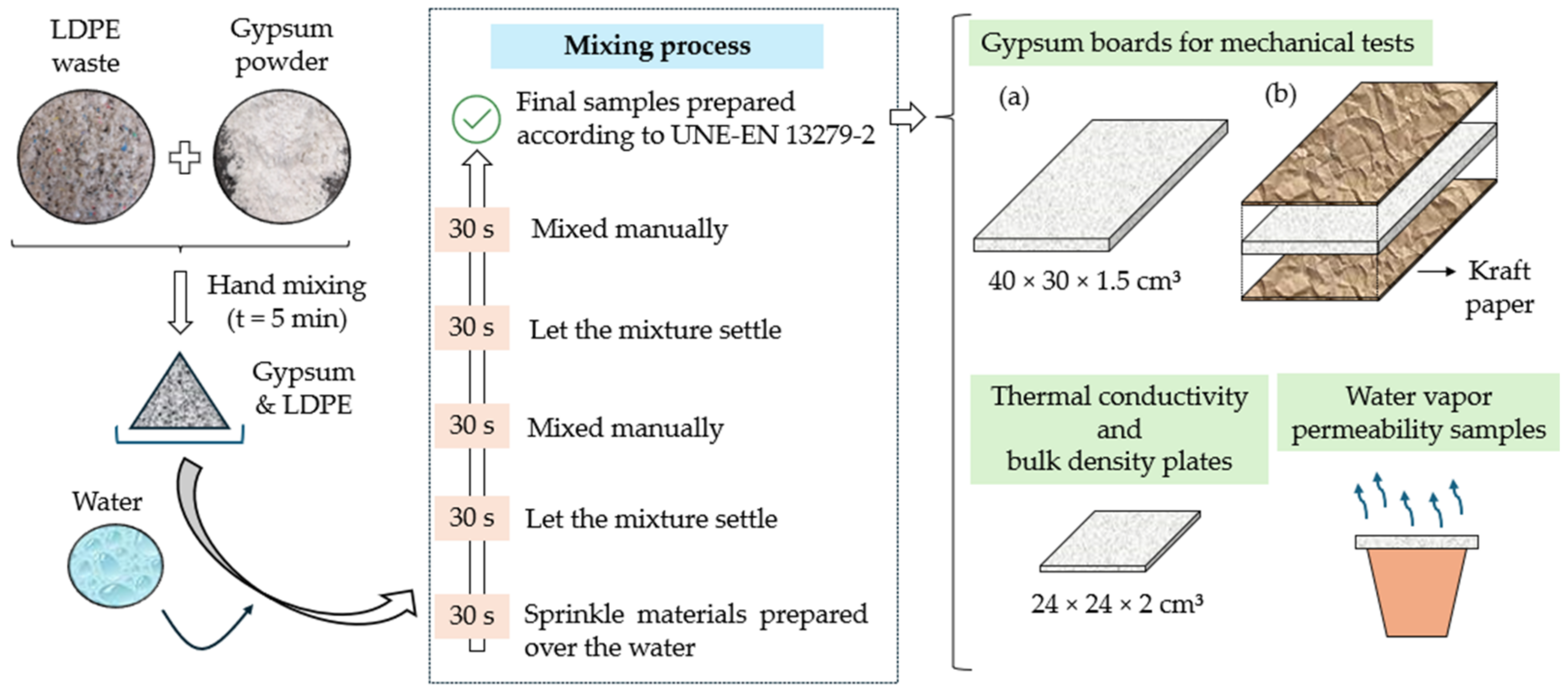
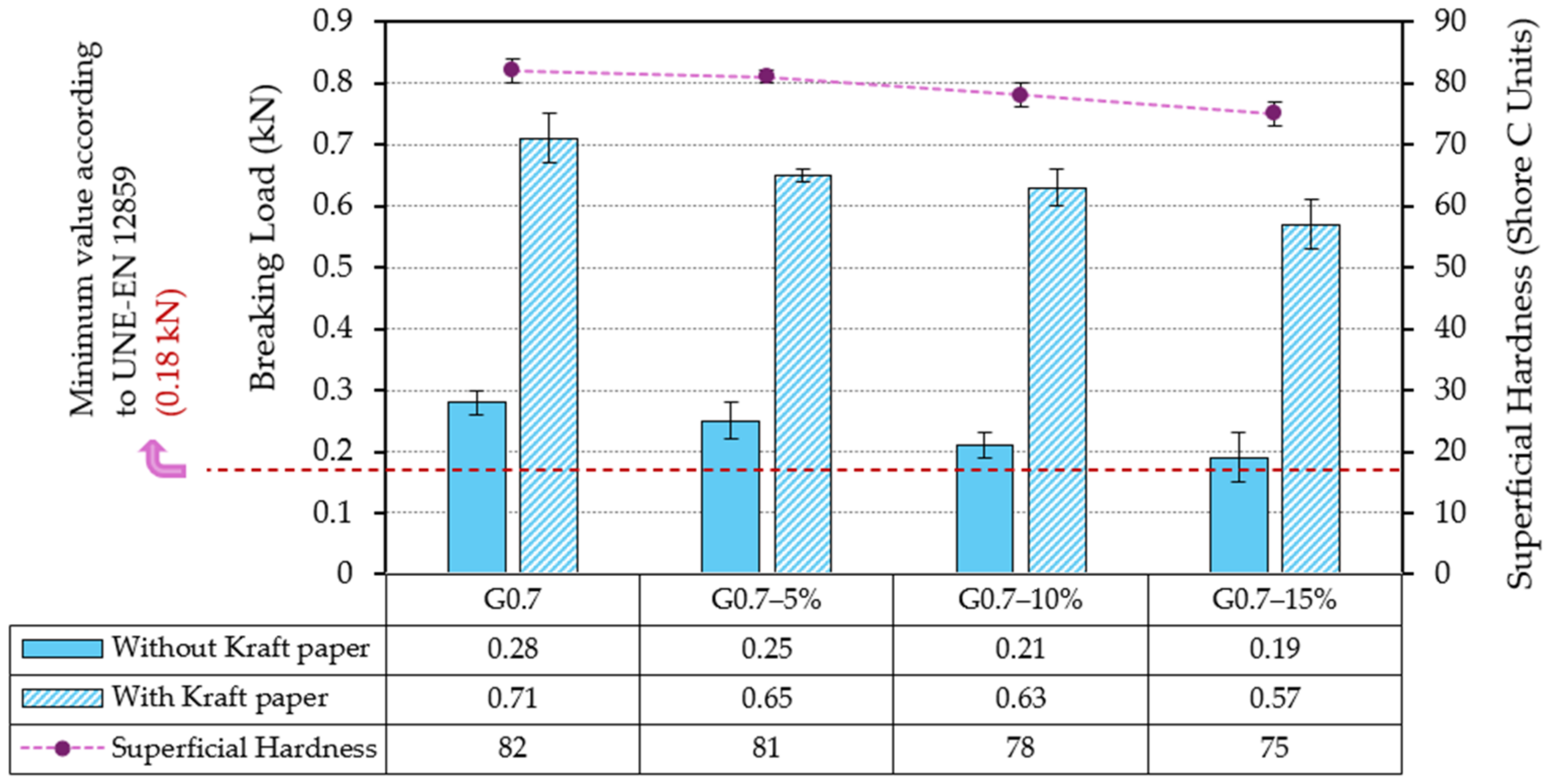


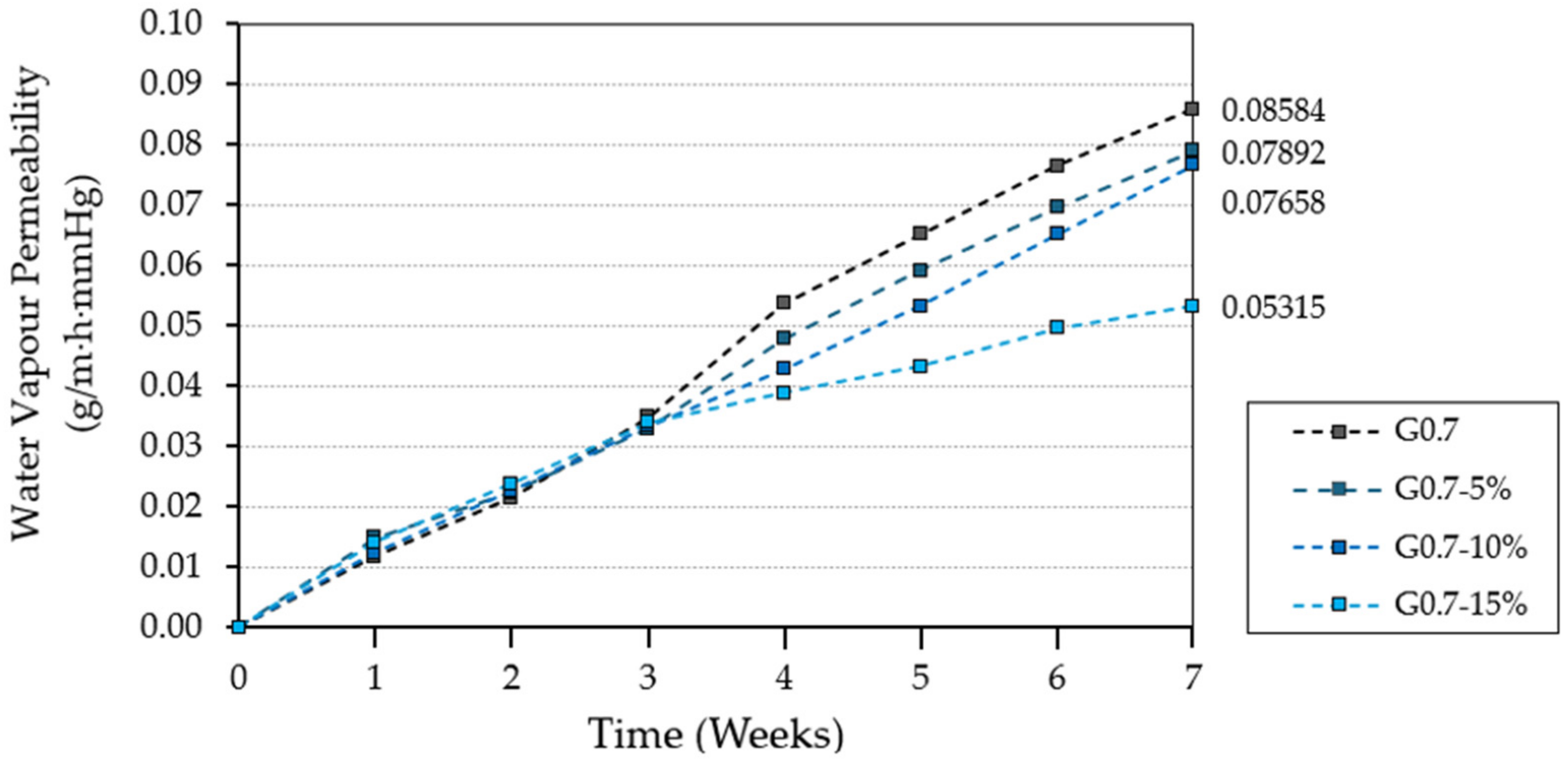
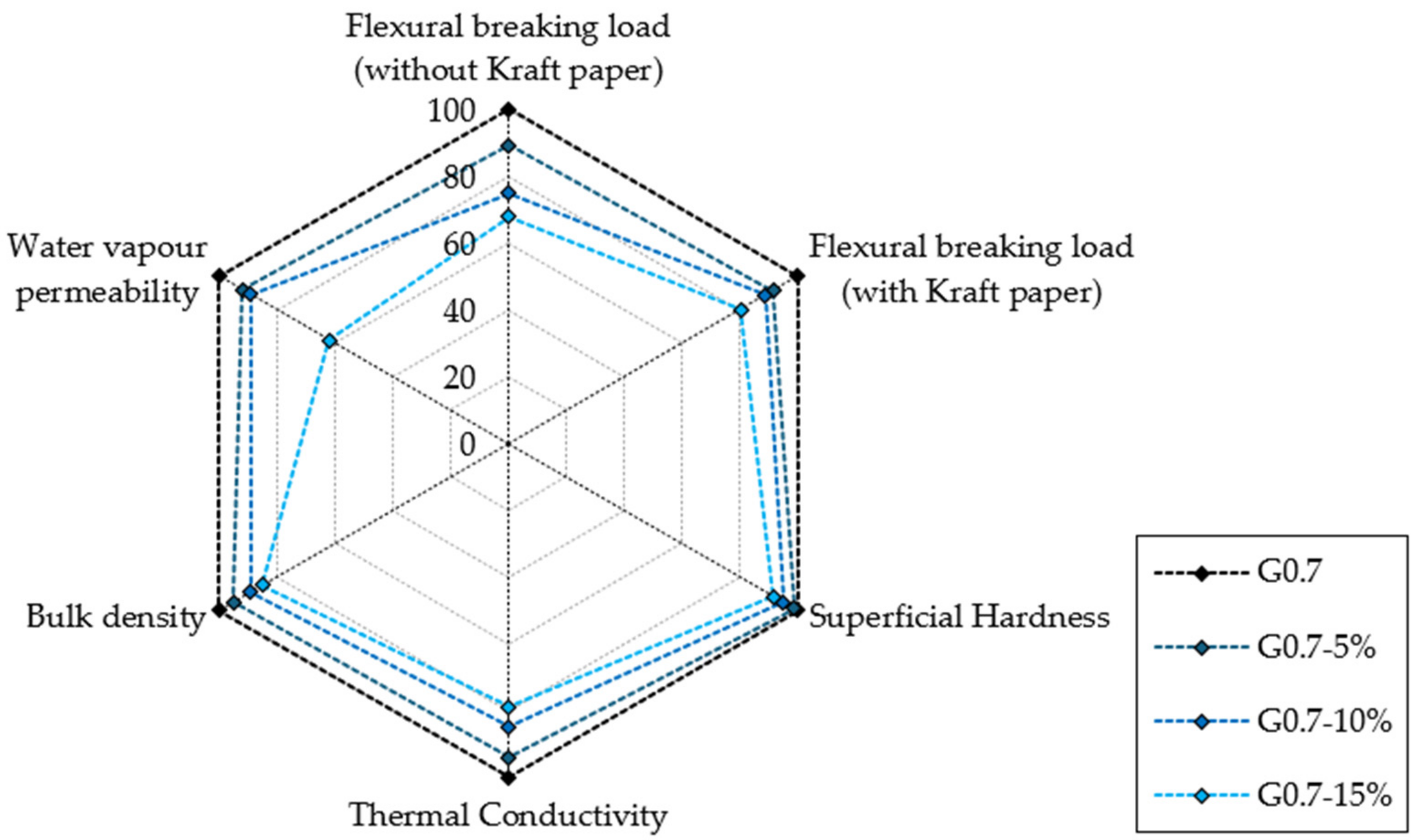
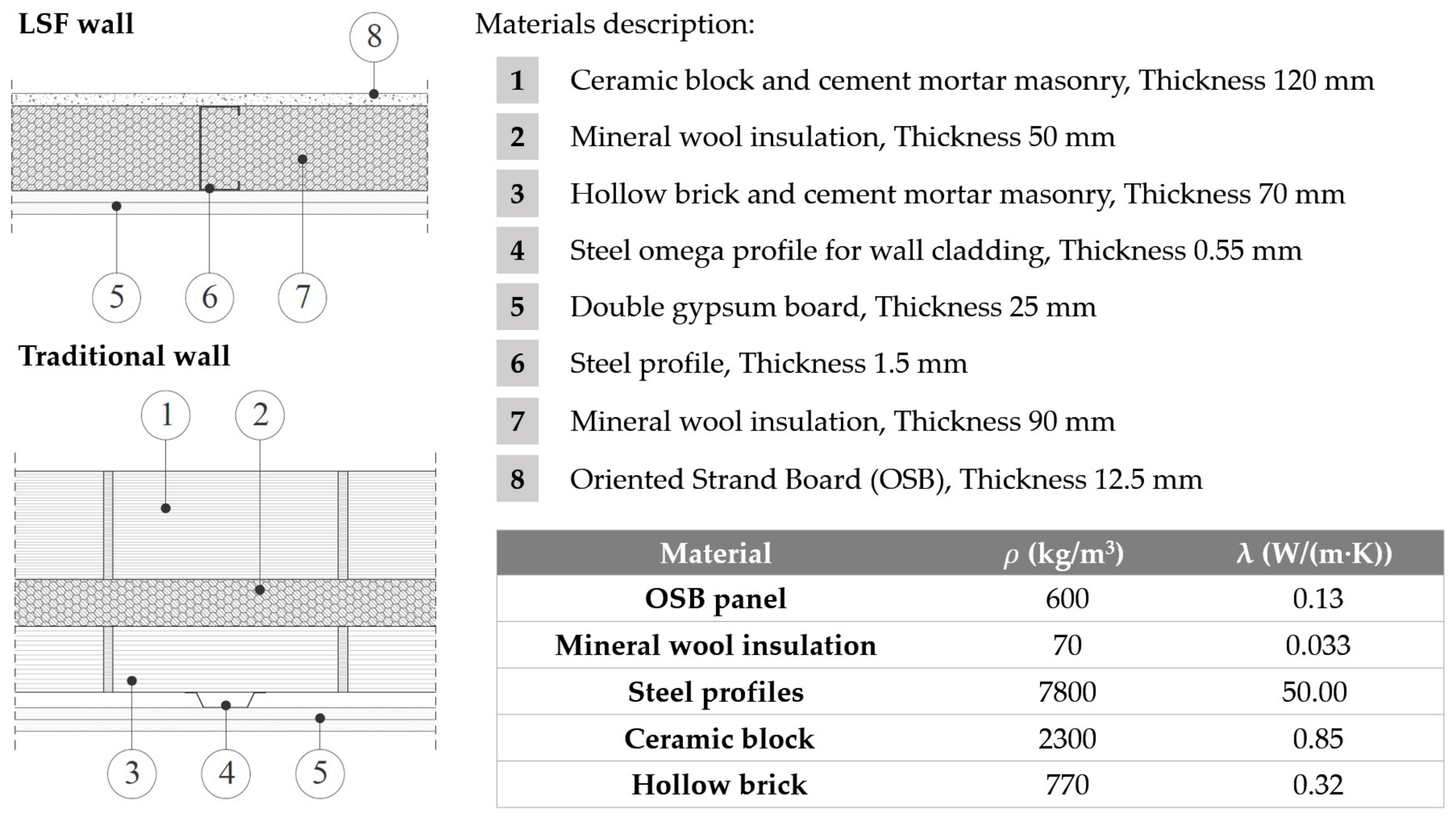
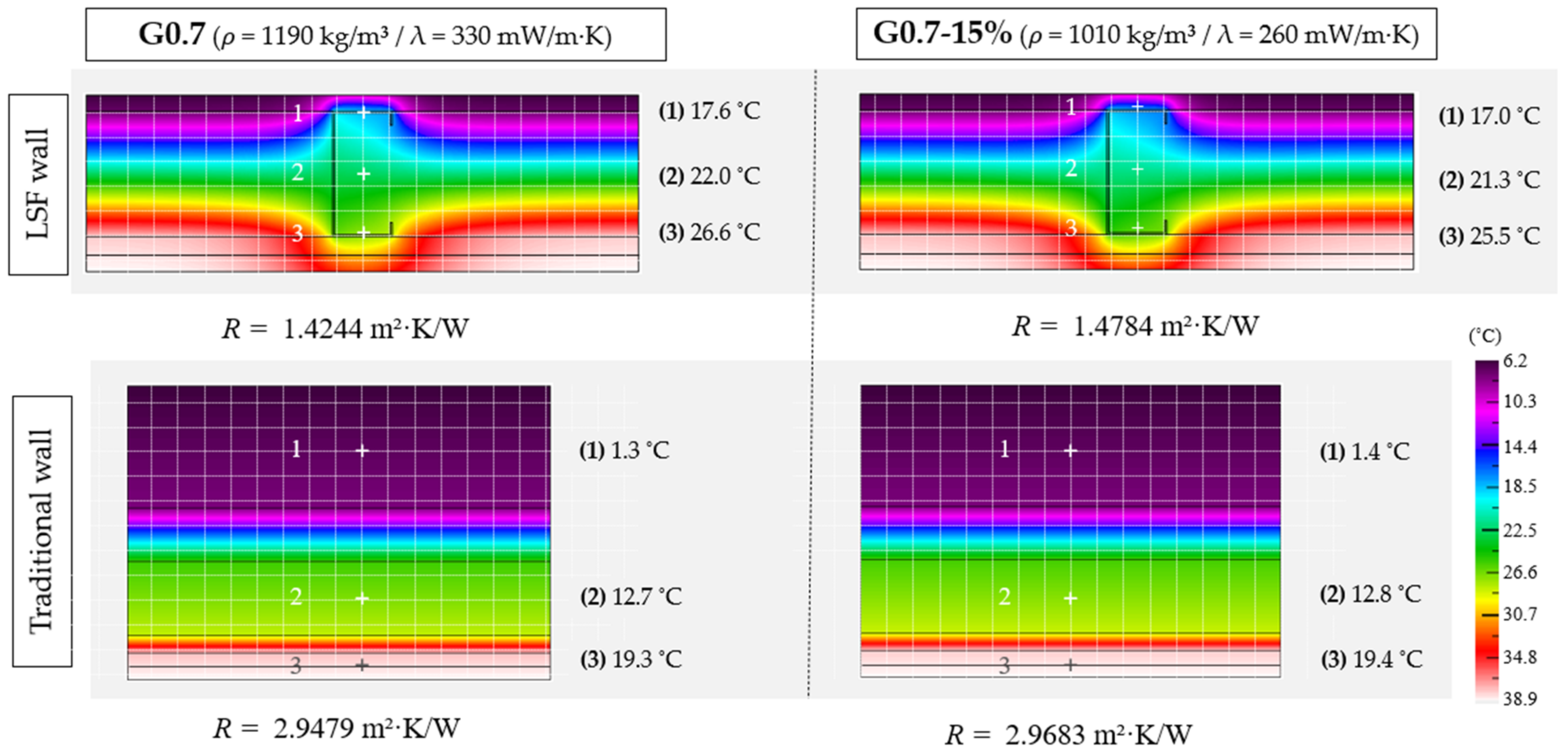
| Ref. | Binder | Waste ** | Size | Addition | Experiments *** | |||||||||||||||||
|---|---|---|---|---|---|---|---|---|---|---|---|---|---|---|---|---|---|---|---|---|---|---|
| A | B | C | D | E | F | G | H | I | J | K | L | M | N | O | P | Q | R | |||||
| [10] | Plaster | Cable plastic | <3 mm | 50–60–70 wt.% | • | • | • | • | ||||||||||||||
| [11] | Plaster | Cable plastic | <3 mm | 50–60–70 wt.%. | • | • | • | • | • | • | • | • | ||||||||||
| [12] | Gypsum | Nylon fibre | 20–25 mm | 2.5 wt.% | • | • | • | • | • | • | ||||||||||||
| PP | <4 mm | 7.5 wt.% | • | • | • | • | • | • | ||||||||||||||
| [13] | Gypsum | Nylon fibre | 20–25 mm | 2.5 wt.% | • | • | • | • | • | • | • | |||||||||||
| PP | <4 mm | 7.5 wt.% | • | • | • | • | • | • | • | |||||||||||||
| [14] | Gypsum | Nylon fibre | 20–25 mm | 2.5 wt.% | • | • | • | • | • | • | • | |||||||||||
| PP | <4 mm | 7.5 wt.% | • | • | • | • | • | • | • | |||||||||||||
| [15] | Gypsum | Polycarbonate | <4 mm | 10–20–30–40 wt.%. | • | • | • | • | • | |||||||||||||
| [16] | Plaster | Cable plastic | <3 mm | 50–60–70 wt.% | • | • | • | • | • | |||||||||||||
| [17] | Gypsum | CDs and DVDs | 0.25–4 mm | 17–35–70 vol.% | • | • | • | • | • | |||||||||||||
| [18] | Plaster | HDPE | 1.4 | 2–4–6–8–10 vol.% | • | • | • | • | • | • | • | • | • | |||||||||
| [19] | Gypsum | PP | 0.13–4 mm | 2.5–5–7.5–10 wt.% | • | • | • | • | • | • | • | • | • | |||||||||
| [20] | Plaster | LDPE | 0.125–1 mm | 1–2–3 wt.% | • | • | • | • | • | • | • | • | ||||||||||
| [21] | Plaster | EPS | 1–4 mm | 0.01–0.05–0.1 wt.% | • | • | • | • | • | |||||||||||||
| [22] | Gypsum | PEFN fibre | 20–30 mm | 0.25–2.0 wt.% | • | • | • | • | ||||||||||||||
| [23] | Plaster | Polyester fibre | 30 mm | 1 wt.% | • | • | • | • | • | |||||||||||||
| [24] | Plaster | EPS and XPS | 1–4 mm | 1–2–3–4 wt.% | • | • | • | • | ||||||||||||||
| [25] | Plaster | ELT rubber | <4 mm | 30–40–50–60 wt.%. | • | • | • | • | ||||||||||||||
| [26] | Gypsum | Polyurethane | <0.5 mm | 50–100–200 vol.%. | • | • | • | • | • | • | • | |||||||||||
| Water Vapour Diffusion Factor | Flexural Strength (MPa) | Compressive Strength (MPa) | pH |
|---|---|---|---|
| 6 | 1 | 2 | >6 |
| Fire reaction (Euroclass) | Granulometry (mm) | Purity index (%) | Usage time (min) |
| A1 | 0–0.2 | 80 | 15–20 |
| Type | Gypsum (g) | Water (g) | LDPE (g) | Raw Material Savings (%) | Setting Time (min) |
|---|---|---|---|---|---|
| G0.7 | 1000 | 700 | — | — | 22 |
| G0.7-5% | 950 | 665 | 20 | 5 | 21 |
| G0.7-10% | 900 | 630 | 40 | 10 | 18 |
| G0.7-15% | 850 | 595 | 60 | 15 | 17 |
| Property | [44] | [45] | [17] | [16] | [18] | [46] | [47] |
|---|---|---|---|---|---|---|---|
| Flexural breaking load (without Kraft paper) [kN] | 0.16 | 0.34 | 0.47 | 0.18 | 0.16 | 0.52 | 0.25 |
| Superficial hardness (Shore C Units) | 73 | 88 | — | 78 | 73 | 63 | 89 |
| Property | [10] | [15] | [18] | [21] | [26] | [44] | [46] |
|---|---|---|---|---|---|---|---|
| Thermal conductivity (W/m·K) | 0.25 | 0.18 | 0.19 | 0.12 | 0.25 | 0.17 | 0.11 |
| Bulk density (kg/m3) | 1023 | 1019 | 1040 | 610 | 753 | 1060 | 833 |
Disclaimer/Publisher’s Note: The statements, opinions and data contained in all publications are solely those of the individual author(s) and contributor(s) and not of MDPI and/or the editor(s). MDPI and/or the editor(s) disclaim responsibility for any injury to people or property resulting from any ideas, methods, instructions or products referred to in the content. |
© 2024 by the authors. Licensee MDPI, Basel, Switzerland. This article is an open access article distributed under the terms and conditions of the Creative Commons Attribution (CC BY) license (https://creativecommons.org/licenses/by/4.0/).
Share and Cite
Zaragoza-Benzal, A.; Ferrández, D.; Santos, P.; Cunha, A.; Durães, L. Recovering Low-Density Polyethylene Waste for Gypsum Board Production: A Mechanical and Hygrothermal Study. Materials 2024, 17, 3898. https://doi.org/10.3390/ma17163898
Zaragoza-Benzal A, Ferrández D, Santos P, Cunha A, Durães L. Recovering Low-Density Polyethylene Waste for Gypsum Board Production: A Mechanical and Hygrothermal Study. Materials. 2024; 17(16):3898. https://doi.org/10.3390/ma17163898
Chicago/Turabian StyleZaragoza-Benzal, Alicia, Daniel Ferrández, Paulo Santos, André Cunha, and Luisa Durães. 2024. "Recovering Low-Density Polyethylene Waste for Gypsum Board Production: A Mechanical and Hygrothermal Study" Materials 17, no. 16: 3898. https://doi.org/10.3390/ma17163898









